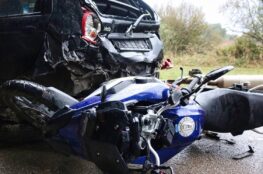Being involved in a hit-and-run accident can be overwhelming and terrifying. In the aftermath of such an incident, it is critical to remain cool and take certain procedures to safeguard your rights and ensure that you receive the required assistance. Understanding what to do after a hit-and-run accident is critical for navigating the aftermath successfully. This detailed guide covers the necessary procedures to take following a hit-and-run accident, assisting you in obtaining the evidence and support required for your case.
Understanding the Impact of a Hit-and-Run Accident
A hit-and-run accident occurs when a driver engaged in a collision flees the scene without giving information or providing aid. A hit-and-run event not only causes physical and emotional trauma for victims, but also presents significant legal and insurance issues. Knowing how to respond to a hit-and-run accident can help you recover damages and seek justice.
Immediate Actions to Take After a Hit-and-Run Accident
When you are engaged in a hit-and-run accident your initial actions can help ensure your safety and bolster your case. Here are the main steps to follow:
Ensure Your Safety:
The first concern following a hit-and-run collision is to safeguard your own safety. If feasible, move your car to a safe position, activate your hazard lights, and check for injuries. If you are critically harmed, contact emergency assistance immediately.
Call the Police
The hit-and-run collision must be reported to the police. Provide them with all relevant information regarding the incident, including the fleeing vehicle’s description, location, and any accident details. A police report is an important piece of evidence that can assist in locating the responsible individual.
Seek Medical Attention:
Even if you don’t feel wounded, it’s critical to seek medical attention following a hit-and-run accident. Some injuries are not immediately visible but might worsen over time. Documenting your medical condition will also be useful for future legal or insurance claims.
Notify Your Insurance Company:
Please contact your insurance carrier as soon as possible to report the hit-and-run accident. Provide them with all of the information and evidence you’ve obtained. Your insurance policy may have procedures for dealing with hit-and-run accidents, and prompt reporting can help expedite your claim.
Legal Considerations Following a Hit-and-Run Accident
Dealing with the legal aspects of a hit-and-run accident can be challenging. Here’s what you need to know:
Understand Your Legal Rights:
Following a hit-and-run collision, it is critical to understand your legal rights. You may be entitled to reimbursement for medical bills, vehicle repairs, and other damages. If the liable party is identified, you may be entitled to file a personal injury claim.
Consult with a Lawyer:
Given the intricacy of hit-and-run situations, speaking with an experienced attorney can be advantageous. A lawyer can assist you in understanding the legal system, protect your interests, and guarantee that you are compensated fairly.
File a Claim with Your Insurance:
If the liable motorist is not found, you may be required to submit a claim with your own insurance provider. This may include using uninsured motorist coverage, if available. Your lawyer can guide you through this procedure and help you understand your options.
Consider Legal Action:
In some situations, you may need to take legal action against the guilty person or your insurance provider. Your lawyer can advise you on whether filing a lawsuit is suitable and walk you through the legal process.
Tips for Improving Your Chances of a Successful Claim
To increase your chances of a successful claim following a hit-and-run accident, consider the following tips
Document Everything:
Comprehensive paperwork is required for a successful claim. Keep track of any medical procedures, repair estimates, and conversations with your insurance provider or legal counsel. This will help your case and provide proof of your damages.
Follow Up with the Police:
Stay in touch with the police while they investigate the hit-and-run accident. Please include any new information or proof you have gathered, and inquire about any progress in locating the culpable motorist.
Stay Organized:
Keep all of your documents and information organized and easily accessible. This includes medical bills, repair estimates, police reports, and correspondence with your insurance provider. Being organized will help you streamline the process and avoid missing any vital facts.
Be Patient and Persistent:
Dealing with the consequences of a hit-and-run accident can be time-consuming and difficult. Be patient throughout the process and diligent in pursuing your claim. To stay up to date on your case, communicate with your insurance company, legal agents, and the police regularly.
Real-Life Examples of Hit-and-Run Accidents and Their Outcomes
Understanding real-life examples of hit-and-run accidents can provide valuable insights into the challenges and outcomes of such cases:
Case of a Fleeing Driver:
In one example, a driver involved in a hit-and-run accident was identified using CCTV footage from surrounding businesses. The victim’s comprehensive documentation and effort in dealing with the police and insurance company were critical in achieving a positive conclusion.
Unidentified Hit-and-Run Driver:
Another example was a victim who was unable to identify the responsible driver but was able to receive damages under their uninsured motorist coverage. This example emphasizes the value of having complete insurance coverage for hit-and-run accidents.
Settlement Through Legal Action:
A third instance featured a victim who sued their insurance company following a hit-and-run accident. The legal case resulted in a satisfactory settlement, proving the efficacy of legal remedies in some situations.
The Importance of Seeking Professional Help
Navigating the complexities of a hit-and-run accident can be overwhelming. Seeking professional help from a lawyer and working closely with your insurance company can make a significant difference in the outcome of your case. Professional assistance ensures that your rights are protected, your case is handled effectively, and you receive the compensation you deserve.
Preventive Measures and Safe Driving Tips
While you can’t control the actions of other drivers, there are preventive measures you can take to reduce your risk of being involved in a hit-and-run accident:
Stay Alert:
Always remain attentive while driving. Avoid distractions, such as using your phone, and be aware of your surroundings. Being alert can help you respond quickly if a dangerous situation arises.
Drive Defensively:
Practice defensive driving by anticipating potential hazards and maintaining a safe distance from other vehicles. This can help you avoid accidents and respond effectively if a hit-and-run situation occurs.
Use Vehicle Safety Features:
Take advantage of modern vehicle safety features, such as collision avoidance systems and cameras, which can provide additional protection and evidence in case of an accident.
Report Unsafe Driving:
If you notice a driver exhibiting dangerous behavior, such as erratic driving or driving under the influence, report them to the authorities. Early intervention can prevent accidents and potentially reduce the risk of a hit-and-run incident.
Also check – How an Accident Attorney Can Help After an Accident?



